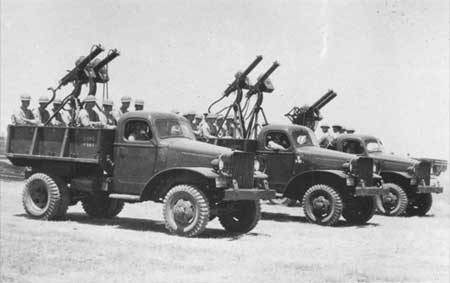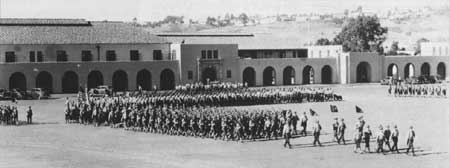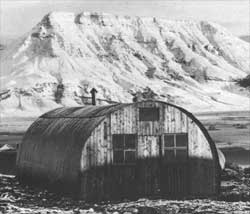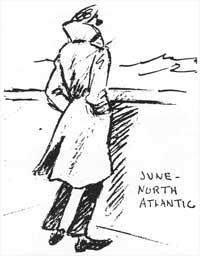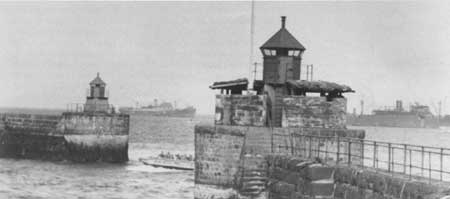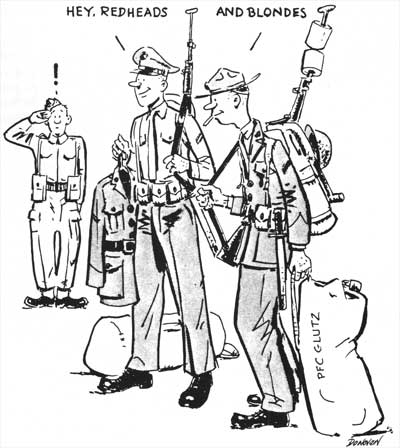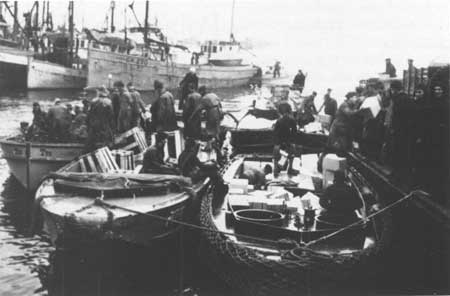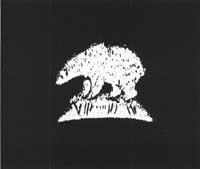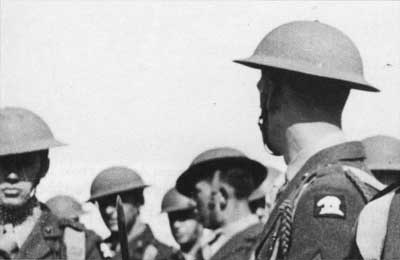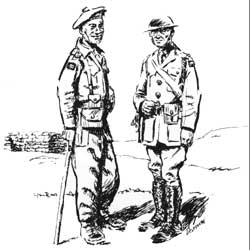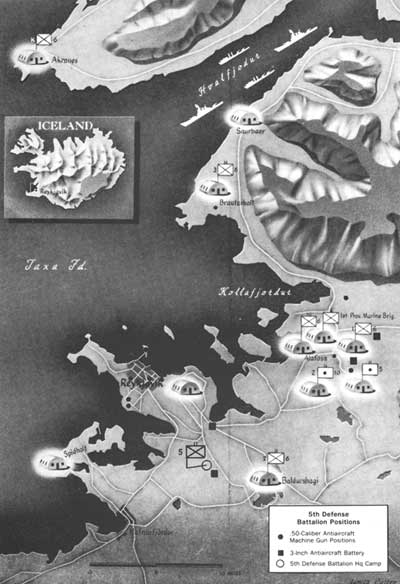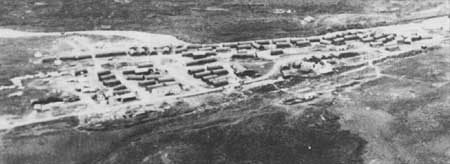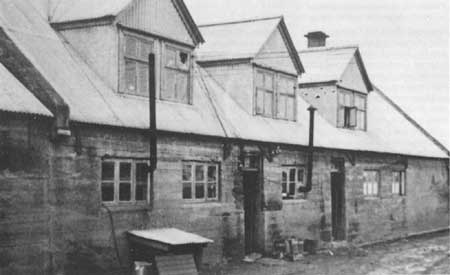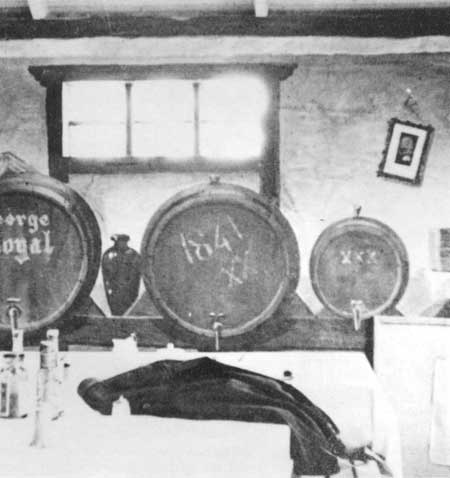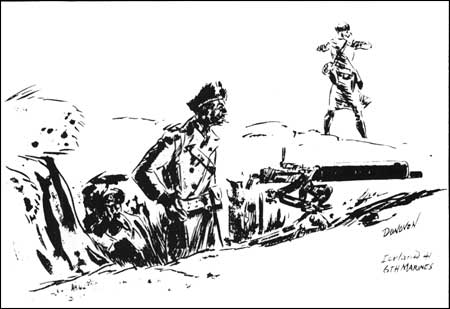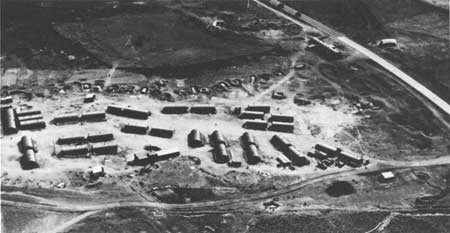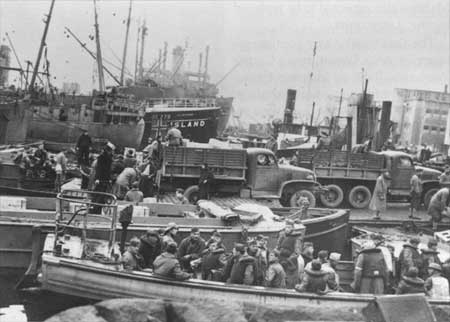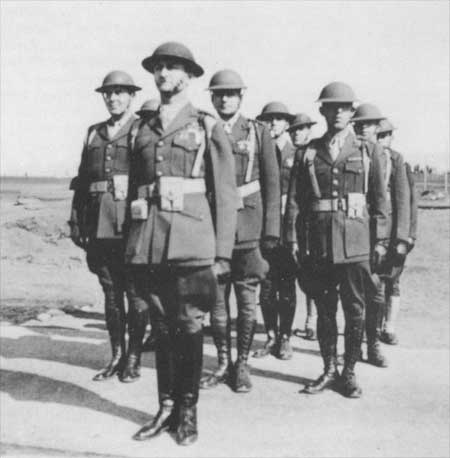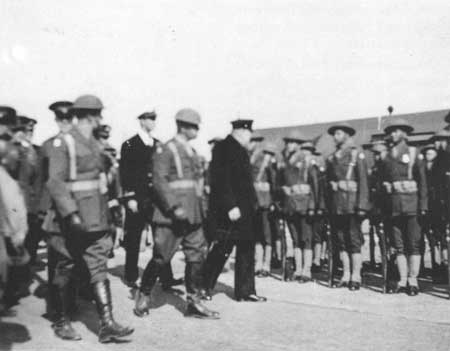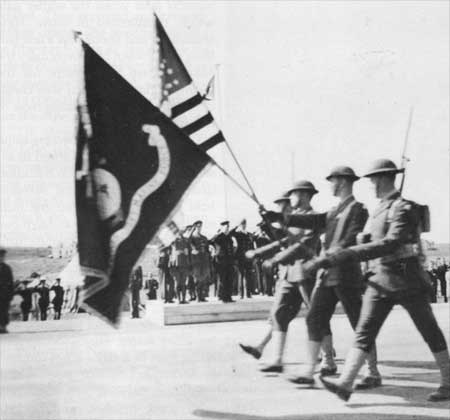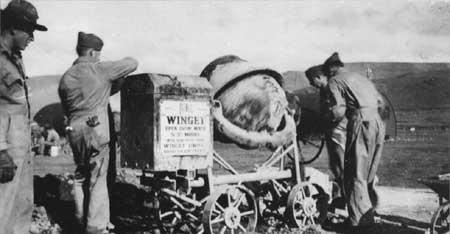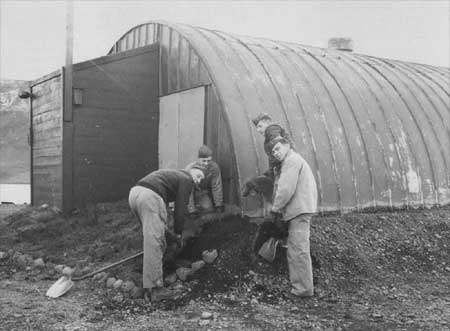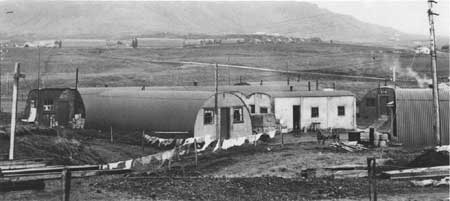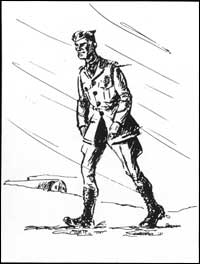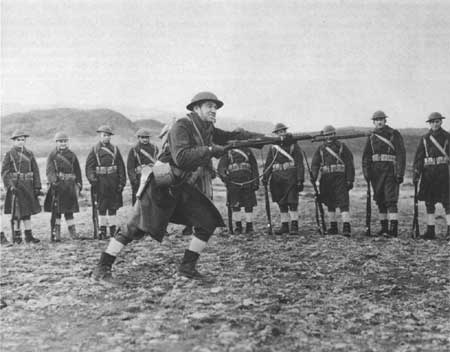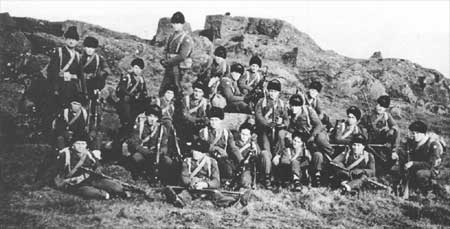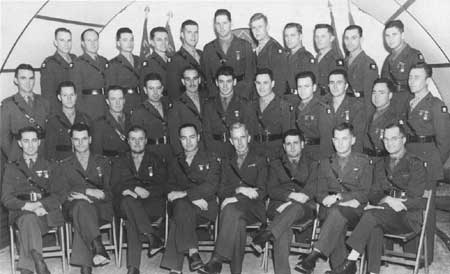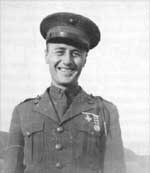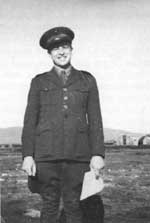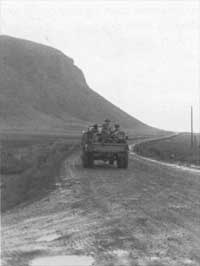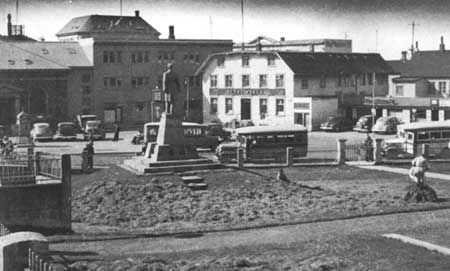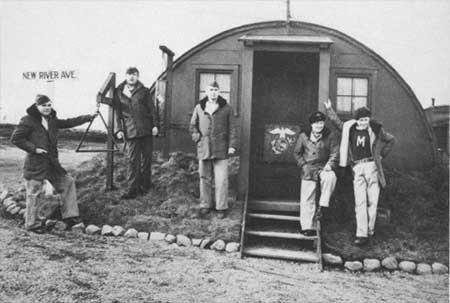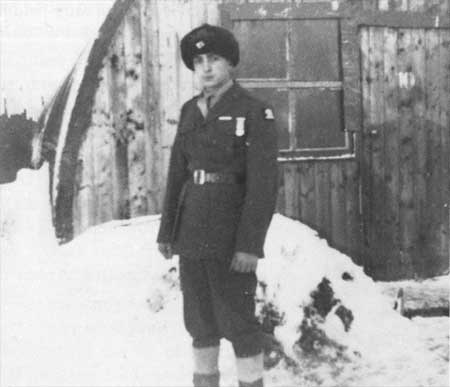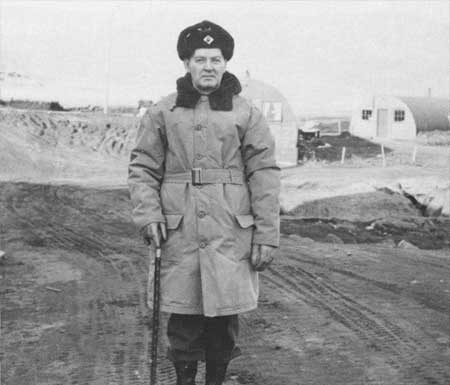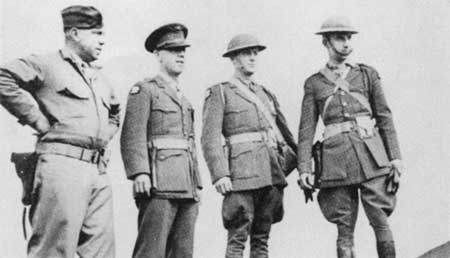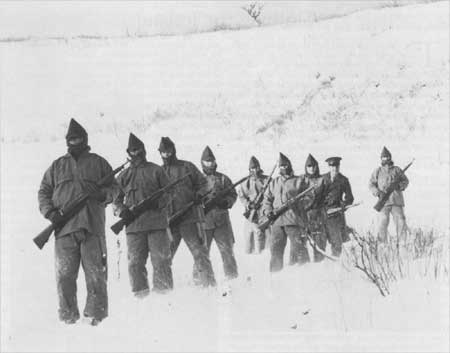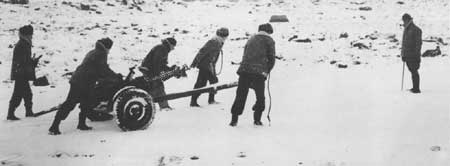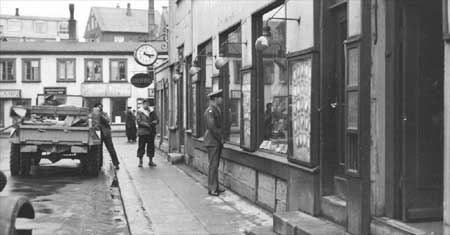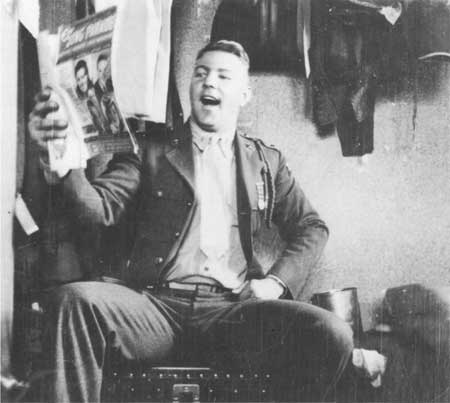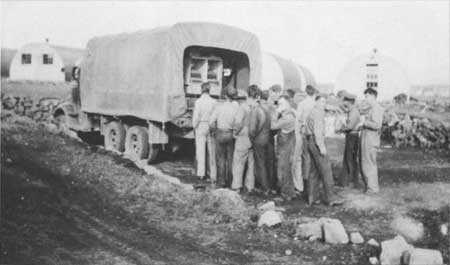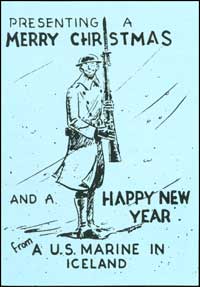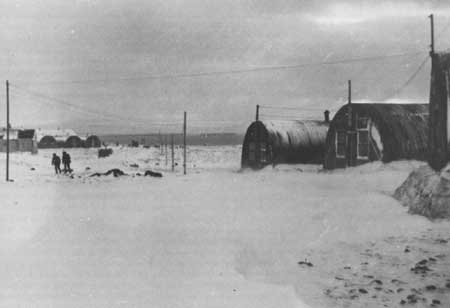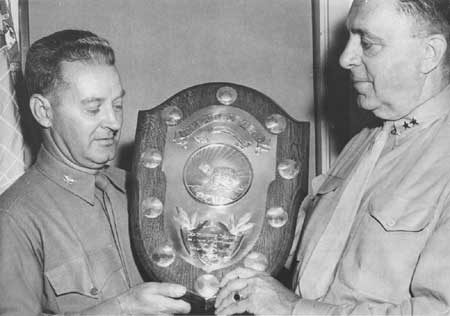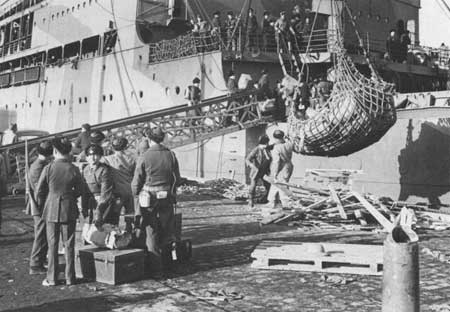| Marines in World War II Commemorative Series |
|
OUTPOST IN THE NORTH ATLANTIC: Marines in the Defense of Iceland by Colonel James A. Donovan, U.S. Marine Corps (Ret) In the early spring of 1941, with the war in Europe a year and a half old, the recently formed 2d Marine Division trained for what observant Marines expected would be an amphibious war against the Japanese in the Pacific. The division was then stationed at Marine Corps Base, San Diego, and also at the newly opened Camp Elliott. Field training for the 6th Marines and the other 2d Division regiments (2d and 8th Marines, infantry; 10th Marines, artillery) was conducted in the scrubby hills and arroyos of Camp Elliott where large wooden, yellow-painted, Navy designed barracks housed the Marine companies and battalions at what is now Naval Air Station, Miramar. Some units were in nearby tent camps.
Unit training consisted of weapons schools, drills, and firing of individual and crew-served weapons. Small unit tactical exercises were run by companies, and there was a considerable number of long-distance hikes. The Marines had virtually no vehicles or motorized mobility, so nearly all movement was by foot. There were very few battalion or larger-unit filed exercises. Night training was minimal. In April, the 6th Marines' landing teams began a series of amphibious training exercises embarked in a group of recently modified freight/passenger ships procured for the purpose. Ship-to-shore drills were held on San Clemente Island, west of San Diego, using the recently developed Landing Craft Personnel (LCP) or "Higgins Boat." This boat had no ramp in the bow, so the Marines had to roll over the gunwales to debark. (The LCPR with a ramp at the bow was not widely available to Marines until after the landing on Guadalcanal in August 1942.) The 6th Marines received a warning order in May 1941 for a possible move to the East Coast to join the 1st Marine Division for contingency operations related to the war in Europe. At the time, the regiment was not yet up to peacetime strength, so the call went out to both the 2d and 8th Marines for volunteers—both officers and enlisted Marines—to augment the 6th. There was no shortage of volunteers. Colonel Leo D. "Dutch" Hermle, a much-decorated veteran of World War I, commanded the 6th Marines. For its move, the regiment was to be reinforced by the 2d Battalion, 10th Marines (with 12 75mm pack howitzers); Company A, 2d Tank Battalion, minus one platoon (with 12 light tanks); a parachute platoon; an antitank platoon; and the 1st Platoon, Company A, 2d Service Battalion. The regiment and the reinforcing units were brought up to a strength of 204 officers and 3,891 enlisted, Marines and Navy, following the arrival of 58 officers and 577 enlisted men from the other units of the division. The division ordered the reinforced regiment to take 10 units of fire for all weapons, gasoline, 30-days' rations, and other supplies. On 31 May, the reinforced 6th Marines mounted out of San Diego with orders to report to the Commanding General I Corps (Provisional), Fleet Marine Force, Atlantic Fleet. At that time, combat loading for an assault landing had not yet become as refined as it was to be later in the war. In any case, the regiment and its supporting units did not know where they were going or what their mission was to be, so the ships were loaded more for convenience than for combat. higher headquarters kept adding items to be embarked, leading some companies to take everything in their camp supply sheds. Most of the Marines embarking with the 6th believed that the force would go to the Caribbean region, so some officers packed summer service uniforms, dress whites, and summer and winter civilian dinner clothes, in addition to all their winter service uniforms. One credible rumor was that they were going to Martinique to guard an impounded Free French aircraft carrier against a potential German takeover. Still another rumor held the Azores as the objective. In the early spring of 1941, the British had, in fact, expressed concern about the security of the Azores which, if taken by the Germans, would threaten both Portugal and the British supply lines into the Mediterranean Sea. British and American staff planners meeting in Washington had been making contingency plans for the growing likelihood of America's participation in the war. In such a case, the United States would relieve the British of responsibility for the defense of Iceland, among other things. While the U.S. Army was rapidly expanding, it appeared that Congressional support for the draft was wavering, which meant the Army could not deploy units containing draftees overseas.
By late spring 1941, Britain's back was against the wall. Prime Minister Winston S. Churchill asked President Franklin D. Roosevelt to send American troops to Iceland to replace the British garrison there. The President agreed, provided the Icelanders invited an American occupation force to their island. Churchill, meanwhile, was having difficulty in securing the invitation and the reluctance of the Icelandic government to issue one very nearly upset an Anglo-American timetable already in process.
A large volcanic island on the edge of the Arctic Circle, Iceland was strategically located for the air and naval control of the North Atlantic "lifeline" between the British Isles and North America. In 1941, France having fallen, Britain alone faced Nazi Germany. Churchill knew that the survival of his nation depended upon support from the United States, and by no means could Iceland be allowed to fall into enemy hands.
At the end of May, the Joint Board of the Army and Navy, formed after the Spanish-American War to prepare joint war plans, approved a contingency plan to land some 28,000 U.S. Army troops and Marines on the Azores under Marine Major General Holland M. Smith. The 1st Marine Division would provide most of the Marine component, but at that time the division was expanding and its regiments were still understrength. It was then decided to reinforce the division with a regiment from the 2d Division and the task fell to the 6th Marines (Reinforced). Lieutenant General Leo D. Hermle 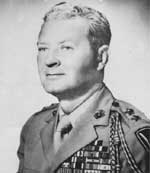
Lieutenant General Leo D. Hermle, who died in January 1976, was born in Hastings, Nebraska, in 1890, and was graduated from the University of California in 1917 with bachelor of arts and doctor of jurisprudence degrees. He reported for active duty as a Marine second lieutenant in August 1917, and sailed for France in February 1918 with the Sixth Marine Regiment. He participated with the regiment in all of its major battles in France, and for his service he was awarded the Distinguished Service Cross, the Distinguished Service Medal, the Silver Star with an Oak Leaf Cluster in lieu of a second Silver Star, and the French Croix de Guerre with Palm and Diploma. He also was awarded the French Legion of Honor with the rank of Chevalier, and was cited twice in the General Orders of the 2d Division, American Expeditionary Forces. For five years after his return to the United States, he served as a legal officer at Marine Barracks, Mare Island, and in the office of the Judge Advocate General of the Navy. During the interwar period, he had duty in the States as well as overseas. As commander of the 6th Marines, he took his regiment to Charleston, South Carolina, where it became the nucleus of the 1st Marine Brigade (Provisional), in June 1941, when it sailed for Iceland. Upon his return to Camp Elliott, California, in March 1942, Colonel Hermle became chief of staff of the 2d Marine Division and traveled with it when it was assigned to duty in the Pacific. Upon promotion to brigadier general, General Hermle became assistant division commander (ADC) of the 2d, and as such, participated with it in the assault of Tarawa. He returned to the West Coast to become ADC of the 5th Marine Division and landed with it in the invasion of Iwo Jima in February 1945. For his exploits, he received the Navy Cross. He was both deputy island commander and island commander of Guam, 1945-1946, and assumed command of the Marine Corps Recruit Depot, San Diego, in 1946, where he remained until his retirement in 1949, after more than 32 years of active service. For having been specially commended for his performance of duty in combat, he was advanced to the rank of lieutenant general on the retired list. he was a professor of law at the University of San Diego for many years following retirement. The ships carrying the 6th Marines consisted of three transports (APs). The 1st Battalion was in the USS Fuller (AP-14), the 2d Battalion in the USS Heywood (AP-12), and the 3d Battalion in the USS William P. Biddle (AP-15) with the regimental headquarters. Each transport's embarkation team included elements of the reinforcing units. There were two destroyer escorts and four fast destroyer transports (old four-stackers), stacks of each of two having been removed to make room for transporting one rifle company. The captains and executive officers of the transports were experienced regular Navy officers, but most of the remaining officers and men were recently called-up Reservists. many of the Marines on these ships had far more time at sea than did most of the ships' companies. While the Marines cruised south to Panama, the war situation in Europe prompted President Roosevelt to reconsider his plan for seizing and occupying Martinique or the Azores and turn his attention to the more immediate threat to Iceland and the relief of British forces there. Washington planners decided to form a provisional Marine brigade at Charleston, South Carolina, with the west coast Marines as its nucleus, augmented by the 5th Defense Battalion from Parris Island, South Carolina. The battalion had been organized at Parris Island on 1 December 1940, with a cadre of officers and men from the 4th Defense Battalion. Colonel Lloyd L. Leech was the initial commanding officer. When ordered to Charleston in June 1941, the 5th Battalion was only partially trained and under-equipped, so emergency requisitions went to U.S. Army antiaircraft artillery commands nationwide to provide the Marine battalion some new weapons and equipment, which were hastily delivered at dockside. Battalion personnel were embarked in the Orizaba (AP-24); guns and cargo were loaded on the USS Arcturus (AK-18) and the USS Hamul (AK-30), two new cargo ships.
The Marines were deployed to Iceland because they were all volunteers, and unlike the draftee-encumbered Army, could be ordered overseas. moreover, the 6th Marines was already at sea prepared for expeditionary duty. On 5 June, Roosevelt directed the Chief of Naval Operations (CNO), Admiral Harold R. Stark, to have a Marine brigade ready to sail in 15 day's time. The brigade was formed on 16 June, the day following the arrival of the 6th Marines (Reinforced) in Charleston. The 1st Marine Brigade (Provisional) was formally organized under Brigadier General John Marston. His new command consisted of: Brigade Headquarters Platoon; Brigade Band; 6th Marines (Reinforced); 2d Battalion, 10th Marines; 5th Defense Battalion (less its 5-inch Artillery Group, which remianed in the States); Company A, 2d Tank Battalion (less 3d Platoon); Company A, 2d Medical Battalion; Company C, 1st Engineer Battalion; 1st Platoon, Company A, 2d Service Battalion; 3d Platoon, 1st Scout Company; and Chemical Platoon. The parachute platoon was detached and reassigned to the 1st Marine Division, which happened also to be in Charleston when the 6th Marines arrived. General Marston arrived in Charleston on 18 June with a small brigade headquarters staff. Admiral Stark's mission statement for the brigade was simple and direct: In cooperation with the British garrison, defend Iceland against hostile attack.
The new brigade, consisting of 4,095 Marines, departed Charleston on 22 June. The men were not unhappy to leave the hot, humid, and noisy Navy yard. Most of the brigade's Marines were kept busy loading ships with additional supplies and equipment procured in Charleston by supply officers, and such incongruous items as skis, ski poles, and winter "protective clothing" purchased by supply officers at a local Sears Roebuck store.
Added to the convoy at Charleston were two cargo ships and two destroyers. It was met outside Charleston harbor by an impressive force of warships and escorts. When the entire convoy began its move towards the North Atlantic, it consisted of 25 vessels, including two battleships, the USS New York (BB-34) and USS Arkansas (BB-33), and two cruisers, USS Nashville (CL-43) and the USS Brooklyn (CL-40). While the convoy was underway, a Marine wrote a letter home on 27 June:
The ships did not yet have surface radar, and so Marines were added to the continuous submarine watches from deck stations. Frequent appearance of U.S. Navy PBY aircraft flying antisubmarine warfare (ASW) patrols reassured the convoy and its Marine passengers. The Marine's letter continued:
The convoy moved into Placentia Bay, Newfoundland, on the night of 27 June, leaving the fog outside. Some officers and men were allowed to go ashore at the small village of Argentia to stretch their legs and see the local scenery. Despite the windy, cold, wet weather, the battalions were able to get ashore at least one day for exercise and limited hikes, which helped to reduce the ill effects of too many hours of confinement and bunk duty on board the transports. During foul weather the only spaces troops had were below decks in their compartments and on their bunks. Major General John Marston 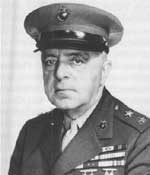
Major General John Marston, who died in November 1957, was born on 3 August 1884 in Pennsylvania, and was commissioned a Marine second lieutenant in June 1908. After five months' training at the School of Application at Annapolis, he began a period of barracks and sea-going duty. This culminated in assignment to the 1st Advance Base Regiment, which landed at and occupied Veracruz, Mexico, in January 1914. In 1915, then-First Lieutenant Marston was assigned to he Haitian Constabulary and operations against the bandit Cacos in Northern Haiti. After three years in Haiti, he served at the Naval Academy and at Quantico, until another overseas assignment, this time to the American Legation in Managua, Nicaragua, where he remained from 1922 to 1924. Following a number of assignments in the Quantico-Washington area, including a brief tour again in Nicaragua as a member of the U.S. Electoral Mission, in 1935 Colonel Marston was transferred to me American Embassy, Peiping. There he commanded the Marine Detachment, 1937-1938, and was senior commander of Marine forces in North China, 1938-1939. Brigadier General Marston became commander of the 1st Marine Brigade (Provisional) in June 1941 and took it to Iceland. Upon return to the United States in April 1942, he was promoted to major general and given command of the 2d Marine Division, moving with it to New Zealand. He returned to the States in August 1942 and was appointed commander of the Department of the Pacific, with headquarters in San Francisco. In April 1944, he was named Commanding General, Camp Lejeune, and served in that position until 1946, when he retired to Lexington, Virginia. The interlude at Newfoundland "to await further orders" continued until 1 July, when the government of Iceland finally, and reluctantly, invited the American occupation that Winston Churchill had requested and promised. On the night of 1 July, the transports upped anchors at 2200 and slowly moved back out to sea headed for Iceland. During the following day, the transports steamed in file behind the Arkansas and New York. Fog drifted over the convoy, fog horns blew every few minutes, and all hands anxiously examined the ships' formation when the fog cleared. One day at officers' school the maps of Iceland were broken out and the staffs began to brief the company officers on the island, its terrain, weather, people, and what the mission would be. On 5 July, a more serious note was added when troops were ordered to wear life jackets at all times, for the convoy was entering the European war zone. Then at 2000 one night the destroyer on the starboard flank picked up a lifeboat with 14 survivors (four Red Cross women and 10 Norwegian sailors) of a ship torpedoed 200 miles to he south on 24 June. Their ships, the Vigrid, a Norwegian merchant ship, had developed engine trouble, fell behind its convoy, and was picked off by a German submarine. The next day the convoy went through the flotsam and jetsam of the British battleship HMS Hood, which had been sunk by the German pocket battleship Bismarck on 24 May. Items of equipment from the Hood floating alongside their ships brought the war to the close attention of sober Marines lining the rails of their transports.
Early in the morning of 7 July, the brigade's convoy approached Iceland and the capital city of Reykjavik. The sea was glassy calm, the sun was well up and bright as it did not set in July in northern lands. The strong odor of fish floated out over the troop ships from the port. A couple of the transports were able to tie up at the small stone quays and Marines lined the rails to examine the people and sights of their new station. Earlier, in May 1941, a battalion of Royal Marines had landed and occupied the capital city, Reykjavik. Ten days later they were relieved by a Canadian Army brigade. The Canadians soon left for England and were replaced by British Army and Royal Air Force units. Some of the replacements were remnants of regiments which had been evacuated from Dunkirk. They were mostly Territorial Army units which are similar to the U.S. National Guard. Antiaircraft artillery units, air defense fighters, and patrol bombers also established island defense installations. Hvalfjordur, a deep fjord 35 miles north of Reykjavik, became the site of an important naval anchorage. Based at an airfield at Keflavik, about 30 miles south of Reykjavik, was a mixed bag of Royal Air Force aircraft including a few Hurricane fighters. It also held some patrol bombers: Hudsons, Sunderlands, and a small group of obsolescent float planes. Most of the British pilots at the field were veterans of the Battles of Britain and were sent to Keflavik for a spell of more relaxed duty. By the summer of 1941, the British contingent had about 25,000 troops in Iceland, including the Tyneside Scottish, the Durham Light Infantry, and the Duke of Wellington's Regiment in the 49th Division, as well as some Royal Artillery field batteries, Royal Army engineers, and other detachments. In addition, 500 RAF personnel and about 2,000 sailors, who manned and serviced the anti-submarine vessels and mine sweepers based at Hvalfjordur, were on the island. British soldiers ("Tommies") in their rugged battle-dress uniforms, heavy black boots, and garrison-type caps cocked over one ear, waved and yelled at the Marines as the American ships tied up at the quay. A few British officers also in battle dress but with peaked caps, swagger sticks, and gleaming leather walked along the quay examining the ships and their Marine passengers. British officers came on board to welcome the Marines and in due course departed with some of the senior brigade staff to confer about landing plans, camp areas, and missions. The cargo ships and the 5th defense Battalion had to unload at the quays, so the troop ships moved out in the harbor, from where they landed Marine style over a small rocky beach named "Balbo" using Higgins boats and a few tank lighters.
The Marines coming ashore from the transports appeared to be a motley crew wearing mixed uniforms and carrying odd personal baggage. Some wore service caps and some wore broad-brimmed campaign hats. Others were in working party blue coveralls, and still others in greens. Some Marines toted sea bags. Some had rifle-cleaning rods stuck in rifle barrels and strung with rolls of toilet paper, some carried their good blouses on coat hangers hooked to their rifles. The British soldiers didn't know what to make of the spectacle. But to be safe, they saluted all Marines who wore peaked caps and neckties because that is what their own officers wore.
One detail the British neglected to discuss with the Marines was the matter of tides in northern latitudes and neither the U.S. Navy nor the Marine planners seemed to be aware of the 14-foot tide which almost washed the landing force back from its small stony landing beach into the cold Arctic seas. Marines unloaded the ships by manhandling bulk cargo equipment, and ammunition from holds into cargo nets which were lowered into the landing craft alongside by the ships' large booms. The boats then ran the short distance to shore where Marine working parties again unloaded the cargo by hand and carried it up onto the beach. Because the Marines had few trucks, they were almost completely dependent upon Royal Army Service Corps two-ton lorries (trucks) to move supplies and equipment to destinations inland. It all went slowly and with hours the tide began to overtake the unloading. The sea came in and inundated the beaches and Marine supplies. Soon cardboard containers of rations, wool shirts, equipment, and supplies were awash or drifting out into the stream. It took a few days to salvage and dry out some of the gear. Regimental supplies and equipment coming into Balbo beach became mixed and piled up in great confusion. The value of the few tank lighters was apparent and the need for a ramp at the bow of the LCPs was also evident. Motorized material-handling equipment, palletized cargo, and weatherproof packing were in the future. Despite the problems with the tide and the narrow beach, the unloading proceeded around the clock. In four days the Marines manhandled and moved 1,500 tons of supplies and equipment from the three transports over the beach and into lorries and to the battalions' assigned camps, some as afar away as 15 miles. The question of command relations had surfaced early in the top-level discussions. The British desired that the brigade be placed under their direct command because they had the major force and its commander was senior to General Marston. But Admiral Stark, the Chief of Naval Operations, had reservations about attaching the marines to the army of a nation at war while the U.S. was still ostensibly neutral. Subsequently, General Marston's orders read that he would coordinate his operations "with the defense operations of the British by the method of mutual cooperation" while reporting directly to the CNO.
When British major General Henry O. Curtis suggested that the Marines wear the British forces' 49th Division Polar Bear shoulder patch, General Marston accepted for the Marines. "The mutual cooperation directive was working to the entire satisfaction of the British Commander and the Brigade. The British complied with our requests and we complied with theirs. It was as simple as that. Our reception by the British has been splendid," General Marston reported to the Major General Commandant on 11 July. "They [the British] have placed at our disposal all of their equipment and have rationed us for ten days to cover the period of disembarkation." The Marine brigade would war the 49th Division's polar-bear shoulder patch with considerable pride. The 49th Division's commander, General Curtis, became popular with the Marines of all ranks by a display of simple leadership and genuine interest in Marine activities, including trying his hand in their softball games.
A special board of officers established by the brigade shortly after its arrival estimated the Germans had varied capabilities to threaten the security of Iceland. They could attempt an amphibious or airborne attack, they could bomb Allied forces and installations, or they could conduct some limited raids from the sea. However, the planning board judged that as long as the British Home Fleet maintained superiority in the seas north of Scotland and areas east of Iceland, the Germans would be unable to support any sizable or prolonged offensive against the Iceland base. The Marine brigade's mission was two-fold: the British division commander designated the 6th Marines (Reinforced), as a "mobile force" for use at any point along the winding coastal road leading from Reykjavik to the naval base at Hvalfjordur. The 5th Defense Battalion service as an air defense unit with the mission of protecting the city, the harbor, and the airfield from German attack. Brigade headquarters was established in the same camp where the 6th Marines headquarters was located — Camp Lumley near Reykjavik. Further up the road, the 1st Battalion occupied two adjacent camps, Victoria Park and Camp MacArthur, about 10 miles from Reykjavik. The camps were near the Varma River, which was unique because its waters were hot, with a temperature of about 90 degrees. It was fed from hot spring nearby and afforded the Marines a warm swimming hole. The 2d Battalion was located at Camp Baldurshagi, near the regimental headquarters. This was an attractive camp in a rocky valley with a stream feeding into a nearby river stocked with salmon. The Icelanders maintained strict fishing rights but the Marines were constantly tempted to cast a line.
In late September, the 3d Battalion was moved to Camp Brauterholt, which was on a wet, rugged, rocky peninsula located near the entrance of Hvalfjordur, the long, deep naval base fjord. The naval base anchorage was a key feature of the Iceland defense area. It was located some 45 miles up the jagged coast from Reykjavik and was surrounded by bleak mountains with no civilian houses nearby. The entrance to the fjord was closed by a submarine net and gate tended by a small British naval vessel. The route leading north to the fjord consisted of a desolate, one-way gravel road with frequent turnouts for passing. Boggy tundra ran along the roadside for some stretches. One side of the road was flanked by water and the other side by steep mountain slopes. The British, worried about parachute attacks, had prepared road blocks at selected locations along the road with fortified strong points. Small garrisons had orders to hold out against any attack until reserves could arrive. When the 3d Battalion assumed this mission, it posted a rifle platoon in a few huts of the key Saurbaer pass. A reinforced rifle company was also sent to the town of Akranes on the north side of the entrance to the fjord.
Camp Brauterholt was a small unfinished camp recently vacated by the British. At Brauterholt and the outposts there was no electricity and no plumbing, only open air heads and mud. The officers mess consisted of an Icelandic cow barn made partially livable by a British officer, a theater designer in civilian life, who painted the barn's walls with scenes of an English village pub. With a large mess table and an adequate galley, it became a center of officer life in the camp. Upon landing and offloading its equipment, the 5th Defense Battalion immediately coordinated with the British command and was integrated with the British defense forces around the port and airfield. The battalion command post was established at Camp Ontario and then moved to Camp Hilton in September. Within a week of landing, the battalion was training, establishing gun positions, and performing camp routines and maintenance. In addition to its three batteries of 3-inch antiaircraft artillery and a battery of 36 .50-caliber heavy water-cooled, antiaircraft machine guns, the 5th operated a number of searchlights and three SCR 268-type radar sets which were most secret and closely guarded. These were the first radars employed by U.S. Marines in the field. No one was allowed near the large rotating, bed-spring-like units, and they remained too secret to even discuss. With a strength of about 950 officers and enlisted Marines, the battalion was widely dispersed among a number of camps at their battery positions covering a considerable area. Battery personnel were located in some 10 small Nissen hut camps in the Reykjavik port and airfield defense sectors. The batteries supplied camp construction working parties which erected many of the Nissen huts and other camp and gun installations. Such construction projects continued until the battalion was redeployed back to the States. During its time in Iceland, the defense battalion performed routine gun watches and training. With conditions of bitter cold high winds, and extreme dampness the maintenance of gun position and standing at continuous gun watches became demanding tasks.
The British army camps taken over by 5th Marines had been purposely laid out in haphazard arrangements of the huts so that enemy air reconnaissance could not identify company or platoon areas. This complicated billeting arrangements for the Marine units, for Marines had been accustomed to uniform, neat, and military camp designs, but in combat zones, they would learn to live in huts and tents dispersed in tactical groupings. British units moving out left a few officers and other ranks in each camp to assist the Marines in getting settled. The British troops enjoyed American rations so much that it was difficult to persuade them after a few days that their assistance was no longer needed.
The British veterans were properly concerned about the German capability of mounting air and parachute attacks. Iceland was well within range of German forces occupying Norway, and during the late summer months of long daylight the Germans sent lone reconnaissance planes high over the island on photo missions, usually before reveille on Sundays.
When the Germans flew over, warning sirens, bells, gongs, and whistles went off. Foggy marines milled around, half dressed, as they donned helmets, gas masks, and their clothes and took up their arms. British antiaircraft artillery fired a few rounds, but usually the Nazi planes were long gone. Because the U.S. was not yet at war, the American flag was not flown over any marine camps purportedly to keep the Germans from identifying them as such. However, some Marines manned .30-caliber antiaircraft machine gun positions and acted as though an invasion was impending. Building their own camps and preparing for winter became priority missions. In addition, the Marines had to ready housing and facilities for the U.S. Army troops who were expected to arrive any day. The Marines' defense mission and the extended area of tactical responsibility in the battalions moving into the key strong points and field fortifications already started or developed by the British. Most of these trenches and weapons positions along with extensive barbed wire obstacles were within short marching distance of the Marines' camps, and so could be occupied fairly quickly. The rifle platoons and weapons squads worked on the positions to strengthen and improve them. Barbed wire was extended, tactical phone lines were installed, and range cards prepared for crew-served weapons. But none of these chores took very long as the defense plans were relatively simple. The brigade devoted most of its time to housekeeping once it had fulfilled its tactical responsibilities. Most Marines enjoyed their new friends in the British Army because of their colorful language, good humor, and seemingly natural affinity for soldiering in the field. These troops were polite, disciplined, and exuded regimental pride and esprit. Their military mannerisms rubbed off on many Marines who found themselves bashing their heels together and swinging their arms in proper British style. Probably most infectious was the British practice of singing ribald pub ditties. The Marines and the British also found some amusement in the one sport they seemed to have had in common — boxing matches. The finals of the Anglo-American boxing tournament were held in the town hall of Reykjavik, kindly loaned by Reykjavik civic leaders. General Curtis and his senior officers sat on one side of the ring while General Marston and his Marine officers sat on the opposite side. The British adjutant announced the Marine band would play the "Star Spangled Banner." All hands stood at attention as the band played. Then the adjutant announced that the band would play "God Save the King." Nothing happened as the Marine musicians searched frantically for their sheet music. Finally a mortified band leader whispered, "Play 'My Country 'tis of Thee' — slowly." In August, the first elements of U.S. Army units arrived in Iceland and brigade Marines were assigned to unload their ships. The arrival of the American soldiers was welcomed because the British forces were planning to return to England for deployment to the fighting in Africa. The Marines also expected to be replaced by the Army units. The first small Army contingents to arrive, on 6 August, was a Curtiss Warhawk P-40 air defense fighter squadron and an engineer battalion. Upon their arrival, the P-40s were assigned to fly air patrols, which generally kept the Germans away. These two units initially reported to General Marston, until a senior Army command group arrived later in September. To meet the date of the Army's arrival and build facilities for the incoming units, the marines had to make a maximum effort. Before deploying to Iceland, the Army's new 5th Infantry Division and supporting units slated for duty overseas had to reorganize by transferring out draftees and transferring in individual regular Army personnel from units all over the States. Army units arriving in Iceland were well supplied with the latest clothing and equipment, and the Marines saw and soon acquired some of this gear.
On Saturday, 16 August, the Iceland Base Command was visited by Prime Minister Churchill on his way home from a meeting with President Roosevelt at Argentia Bay in Newfoundland, where they had forged the Atlantic Charter. The British and U.S. Marine forces put on a grand review and parade which consisted of several miles of troops with platoons in line stretched along a major road under a bright sky. Mr. Churchill, with his cane and cigar, walked the entire line, and everyone claimed Churchill looked him in the eye. When Churchill passed along the ranks of the 6th Marines, he stopped to speak to some of the older men wearing campaign ribbons. One senior Marine staff sergeant of German descent had groused earlier about parading for the British Prime Minister, but when Churchill stopped and asked him, "You're an old soldier aren't' you?" The Marine retorted, "I'm an old Marine." Churchill then said, "Well an old sea soldier, is that a good term?" The sergeant replied, "Yes, sir. We like to regard ourselves as sea soldiers." Churchill asked him if he would shake hand with another old soldier. Mr. Churchill won over that Marine and all others he spoke to that day.
Then Mr. Churchill mounted a small reviewing stand with the official party, including the senior Marines, General Marston and Colonel Hermle, and the march-past stepped off led by the brigade Marine band and the 6th Marines. The parade was relatively long and the smartly turned out troops were impressive. For many Marines a stirring highlight was the skirling of the bagpipes and the beat of the drums of the Tyneside Scottish pipe band. The "Marines' Hymn" was played loud and clear by the Marine brigade band as the Leathernecks gave Churchill their best. Churchill was later quoted as saying the "Marines' Hymn" so impressed and moved him that it stayed in his mind long afterwards.
Shortly after they arrived, the Marines commenced the activities that were to take up most of their time in Iceland. They repaired and expanded their camps. The reasons given for the Marines having to devote their efforts to building camps for other than their own use were: First, somebody had to construct camps to accommodate the expected arrival and buildup of U.S. Army forces and neither Icelandic labor nor British troops were available to do so. Second, it became apparent that the Marines were not going to leave soon, so they had to work on imporving their own camps in preparation for the coming winter. They constructed new camps, setting up dozens of the British Nissen huts. They built and maintained roads, constructed defense installations, and functioned repeatedly as stevedores at the Reykjavik docks—but putting up Nissen huts seemed to be their never-ending task. Some officers in the regiment described themselves as a "labor regiment."
Battalion given the mission of constructing additional Nissen hut camps sent platoon-sized working parties to selected sites and with the technical supervision of a few Royal Engineer NCOs turned to and demonstrated American speed and industry. Sixteen-hour work days were not unusual and numerous additional camps were constructed in a matter of weeks. The Marines quickly learned how to assemble the prefabricated huts after a few halting starts.
As the Nissen huts were being constructed, the Marines were told to bank sod three- to four-feet high around the foundations and to tie down the tin roofs with strands of barbed wire. This seemed to be foolish and excessive precautions until months later when the winter gale winds commenced to blow. Huts shuddered and shook and a few had their ends blown out. Eventually the Marines even built camps for the Army engineers, which was considered an ironic and amusing twist of duties by the Marines.
Construction crews became quite proud of their skill and speed in assembling the huts. The 1st Battalion desired to show General Marston how fast they could put the huts together. He showed up at dawn one day with his camera to take pictures showing daily progress. He planned a few pictures each day. He should have taken them hour by hour. By 9:00 p.m., the crews were completing roofs, doors, and windows, and installing stoves. The crews completed 16 huts in a day—a not-unusual performance. Marines did their own laundering with soap, brushes, and buckets which were issued to them. The long summer days were warm enough to dry laundry hung outside—except during Iceland's frequent rain showers. In the winter, with the short days and bad weather, and freezing winds, drying clothes outdoors became impossible. As a solution to the problem, many camps provided Nissen "drying huts" with laundry lines and continuous heat from burning stoves. most officers did their own laundry and hung the wash in their sleeping quarters.
On 22 September 1941, President Roosevelt ordered the Marine brigade to report for duty under Major General Charles H. Bonesteel, U.S. Army, the newly designated Commanding General, Iceland Base Command. Historic prejudices and differences of methods and discipline, and Major General Commandant Thomas Holcomb's memory of service in France where the Fourth Marine Brigade served under the Army, prompted him to protest this new arrangement to the Chief of Naval Operations. But command relations where changing world-wide and the Iceland Marines were directed to carry out their orders. The law provided that Marines could be ordered by the President to detached duty with the U.S. Army. When this occurred, the detached Marine organizations became an operational part of the Army. They were then subject to the Articles of War and were no longer governed by the Articles for the Government of the Navy. The Marines had to convert to the Army courts-martial and legal systems which tended to conflict with traditional Marine Corps disciplinary procedures. The brigade did not relish the new arrangement. Army Chief of Staff General George C. Marshall directed the Marines to adapt to he Army's administrative system as well. General Bonesteel made a point of expressing the Army's gratitude for the Marines' "splendid assistance in the preparation of the various campsites and numerous other ways prior to and during our arrival in Iceland. The amount of hard and extended labor involved is fully recognized and deeply appreciated."
By late September, Marine leaders saw problems arising from a combination of short, dark days, bad weather, and troops bored and confined to quarters. One lieutenant wrote to his mother suggesting that the ladies in her church might be interested in sending the troops some playing cards, board games, dice, checkers, and similar items. Within weeks the lieutenant was overwhelmed with the requested games and supplies, plus large parcels of cookies and candies. In October, as the days grew shorter, it rained, temperatures dropped, and the wind blew incessantly. The ability to accomplish any meaningful field, tactical, or weapons' training lessened as the weather deteriorated. Many units were still busy improving their camp facilities and preparing for a wet, muddy winter. Officers spent hours censoring their men's mail and the men spent hours writing letters. Most junior officers had time-consuming extra duties and the troops were assigned to seemingly unending working parties. Tactical plans, trenches, emplacements, wire obstacles, and defense range cards for sectors of responsibility, had all been prepared during the early and balmy weeks of fall. When the weather permitted, the Marines played baseball and otherwise tried to keep in good physical condition by long-distance hikes and some cross-country runs on the grassy fields with their strange hummocks, rocks, and pools of mud. Marines who fell in the muck amused their comrades who needed all the laughs they could get. The brigade held no field maneuvers or large staff exercises until Major General Bonesteel arrived. He attempted to conduct some field exercises with the brigade units located near Reykjavik and the air base. The 3d Battalion was too far away at Brauterholt peninsula to participate and was just about completely immobile by the lack of any wheeled transport.
Some joint Army-Marine command post exercises were conducted for the staffs. When the weather and darkness began to restrict field training, some units of the brigade initiated schooling for both officers and enlisted Marines. The 1st Battalion, commanded by Lieutenant Colonel Oliver P. Smith, who was well schooled himself and a graduate of France's Ecole de Guerre Superieure, held officers' schools on military subjects. Meanwhile, Lieutenant Colonel William A. Worton, commander of the 2d Battalion, was interested in establishing literacy classes in "everything from simple arithmetic to calculus." Lieutenant William C. Chamberlin, a Phi Beta Kappa graduate of Dartmouth College, who had been working in his spare time on his doctorate degree at the University of Iceland, was made "Headmaster" of the battalion's schools which employed officer and NCO teachers. Eventually more than 125 Marines attended classes in a variety of basic subjects. It helped to keep young minds busy when they had very little else to occupy their spare time. Before it had become too dark during the days, there had been a fair amount of range firing of crew-served weapons—machine guns and mortars—but field exercises were just no longer feasible now. During their deployment to Iceland, the firing batteries of the 2d Battalion, 10th Marines, had been attached in support of the three infantry battalions of the 6th Marines and initially were located adjacent to the infantry camps. In the late fall, the batteries were returned to their parent battalion control and relocated at a new camp, Camp Tientsin. This move was made to facilitate artillery technical training and permit more efficient field firing planning and execution by the battalion.
In the ever-darker winter weeks, almost all military training came to a standstill. Close-order drill in the morning by moonlight was just not effective. Rifles' barrels had to be inspected indoors by lamp light reflected from a thumbnail placed in the chamber. Some weapons drills were held in the huts. Much time was dedicated to ensuring the health and comfort of the Marines without losing sight of the defense mission. It wasn't easy. The wind blew constantly with gusts of 70 to 100 miles per hour and the Marines settled down to whatever training they could conduct in their quarters. A traditional pastime which always kept Marines busy was to maintain personal gear with "spit and polish." The M1903 Springfield rifle had a wooden stock made of carefully selected walnut. It took a beautiful polish when linseed oil was rubbed into the wood by the Marine's palm. His rifle was his personal weapon, constantly inspected and handled with care and pride. The other habitual Marine practice was to shine the issue chocolate brown-colored, high-top leather shoes to a high gloss. Dealing with their own and their Marines' sheer boredom became a real problem for both junior and senior commanders. Mail call, though the letters and packages often arrived late in battered and tattered condition, very often wet, was a highlight in a day's schedule. Enlisted marines were issued two free cans of beer per day from the post exchange, an event which also broke the monotony. As always, card games for high stakes were a popular pastime. Most of the gamblers' pay "rode the books" as there was no place to spend it. Because there was little to read, one company commander often to a book to his men's huts and read to them as they and their salty and grizzled NCOs sat at his feet and listened with rapt attention. Some nights he sneaked in a bottle of whiskey for the men. They described these visits as "the skipper's mail call."
With the advancing cold weather and snow, each battalion formed an ad hoc "ski patrol" with a potential mission of rescuing crews of downed aircraft or to find persons lost in the rugged country. The patrol consisted of an officer and a few men, mostly from New England, who claimed to be experienced skiers. Their chief problem was that they had no supply of proper ski boots or bindings or wax. The skis purchased in Charleston were simple wooden ones with a toe strap only, and the poles provided were basic beginner's bamboo sticks. The snow was never deep enough around Marine camps for good skiing and fortunately there were no emergencies calling for a ski patrol rescue. As noted earlier, a major difficulty facing Marine units in remote outpost camps was the shortage of transportation. Marine infantry battalions had no motor transport of their own—neither jeeps nor trucks, prime movers nor weapons carriers. The 2d Battalion, 10th Marines, had small, one-ton truck prime movers for its 75mm pack howitzers. The brigade had a motor transport platoon with some old two-ton trucks. The defense battalion had a few vehicles, but there were no general-purpose, staff, command, or utility vehicles in the brigade. Only the generosity of the U.S. and British armies, which loaned the Marines a small number of trucks enabled them to meet the most basic logistic requirements. The British had also loaned the Marines a few of their small "staff" or reconnaissance vehicles which were little more than four-cylinder sport cars painted olive drab. The Army generously provided the brigade with some jeeps and 3/4-ton trucks available to transport Marine working parties and for logistic support. Lack of motor transport was a continuing problem for the brigade for most of its time in Iceland. With the dearth of motor vehicles and material handling equipment, the Marines continued to move by foot and to use their backs to handle supplies. One benefit was that most enlisted ranks kept physically fit despite the lack of a formal physical fitness program.
Recreation for Marines in the city and vicinity of Reykjavik was very limited. The few existing restaurants were small, barely able to serve both the local citizens and a few British and American troops. There were only two small movie theaters and the Hotel Borg—the largest and best in town—which were the centers of the Icelanders' social life. The Borg attracted the Allied officers to its dances but was "out of bounds" to enlisted troops. Single girls frequented the hotel to dance with the officers and even to establish some promising friendships.
The staff non-commissioned officers had a favorite restaurant and the lower ranks made do with what facilities were left, which weren't much. Travel was so difficult that many Marines decided that going to town wasn't worth the effort required.
The Marines had brought with them a few musical instruments, such as guitars. As time passed, the Red Cross provided additional recreational equipment, radios, and record players. As the troops were forced to depend upon their own resources, they soon produced several clever and amusing shows.
Movies for the Marines weren't available until September. The brigade had brought no projection equipment with its expeditionary combat gear. One projector was passed around the battalions of the brigade, which then used living huts or mess buildings for shows once or twice a week until they could finally build recreation huts. Eventually some of the camps were able to construct recreation huts for movie shows, where the small beer ration could be dispensed, and in which a small post exchange could be set up. Previously, a truck would visit the camps periodically with a selection of post exchange items such as smoking, washing, asn shaving supplies. During the winter months, the recreation buildings served to provide space for small libraries, barber service, amateur shows, classrooms, and religious services.
The battalion camp galleys were primitive at best and tested the skills of the cooks and frequently the stomachs of the Marines, but at least the rations were usually feshly prepared and warm. World War II combat rations had not yet appeared. Rations were never elaborate or fancy but were healthy and adequate. Meals were made with frozen, dried, and tinned foods prepared on old Marine Corps World War I-vintage, kerosene-burning, trailer-mounted "buzzacot" stoves. Beans, forzen fowl, salmon, mashed potatoes, corned beef, stew, canned fruits, posdered milk, coffee, and some baked goods were typical items on the menu. (Officers were charged fifty cents per day for rations.) The menu was repeated every ten days. There were no field combat rations. Troops ate from their Wolrd War I mess kits: two pans with a handle and steel spoon, knife, and fork. Each man washed his own mess kit in GI cans holding boiling soapy water followed by a dip in boiling clear water. Nobody suffered, but it was an intiquated system.
With the arrival of the Army, the Marines changed from Navy rations to the Army menu which included experimental field rations consisting largely of Spam, sausage, and dehydrated items. The Navy had been supplying an acceptable variety of canned and dried foods, but the new Army rations werent' very popular with most Marines. There was no refrigeration, no running water in the galleys, and no good way to heat water until the Army brough in No. 5 coal ranges and immersion heaters to heat water to boiling for washing the men's mess gear. Prior to this, water had been heated on the cooking ranges. The mess hals had rough wooden benches and tables, and both the galleys an mess halls were pungent with the odor of mutton and codfish obtained from local sources. Messmen described the day's menu as "mutton, lamb, sheep, or ram." Local milk and cheese products were prohibited because it was reported that many of Iceland's cows were tubercular. The Marines were issued a highly concentrated chocolate candy bar as a "combat" rations to be consumed in case the Germans attacked and other rations were not available. one gunnery sergeant dubbed this ration "the last-chance goody bar." Communications in the brigade were primitive even by the standards of World War II. The primary means of tactical and administrative communications were the land lines and sound-powered telephones whic h tied together companies, battalions, regiments, and brigade. Battalion and higher headquarters had radio equipment that could be broken down into man-pack loads and were powered by hand-cranked generators. Eventualy gasoline-powered generator units provided electricity for radios as well and camp lighting. World news and information of events at home came mostly from naval channels and personal mail, which took tow to four weeks to arrive via destroyers. A brigade weekly newspaper, The Artic Marine, provided some world ne3ws, American sports news, some local news items, and Marine humor.
As the winter days passed, and no movement orders had been published, the Marines began to face the possibility of an indefinite stay in Iceland. They had no way of knowing that in November, powers in Washington had decided to begin redeploying them early in 1942, when more Army troops were scheduled to arrive in Iceland. The brigade would then return to the United States on the Army transports which brought soldiers. When word spread of the pending move home, griping about the dark, dull life in the barren camps declined and the days became more bearable. The prospect of returning to Marine Corps command was also heartening. During the weeks leading up to 7 December and the entry of America into the war, the Marines had no real morale problems outside of the boredom already described and an inability to wander far from their camps. After 7 December, attitudes, motivation, and interests focused upon the Pacific War and the fate of Marine friends attacked and captured by the Japanese at Wake Island, Guam, China, and the Philippines. The outbreak of the Pacific War didn't change the conditions under which the Marines existed in Iceland, as they were already in a war theater and on war alert. There had been rumors of the Marines going elsewhere than home when the Army arrived, but no firm plans had been prepared, at least on the brigade level. After 7 December, the Marines' great fear was that they would be left in Iceland. There were no more complaints by troops about Iceland hardships, they just wanted to get to the Pacific. Christmas 1941 was a relatively good day for the marines. They enjoyed a proper holiday meal of turkey, baked ham, and the other traditional elements of a Christmas dinner plus free beer and cigars. The Navy had provided a number of small trees for the mess halls and all hands turned to in efforts to do some appropriate decorations. The first really heavy snowfall blanketed the drab camps to provide a proper white Christmas. Some fortunate Marines who had made friends with Icelandic families were invited to their homes for the evening. Marine officers and some British officers enjoyed traditional family celebrations to which they were able to contribute some gin, nuts, fruit, candy, and items not easy for the Icelanders to obtain. These hospitable families shared their children, food, songs, and good will with the soldiers and Marines occupying their country. It was a memorable and merry day for all. By January, the wind was blowing so hard and so constantly, many camps had to install hand lines from the huts to the heads and mess buildings to help keep all Marines from being blown and sliding off the paths into the mud. Major David M. Shoup wrote his wife on 20 January 1942:
In January 1942, the brigade received orders to begin moving home. The redeployment was to be executed by battalions. First to leave was the 3d Battalion, scheduled to depart on 31 January. The battalion quickly turned its camps over to Army units and embarked, but not until it had set up the Army's metal bunks and made up their beds (as ordered by Iceland Base Command). The Marines short-sheeted most of the bunks as a farewell gesture to the soldiers. The advance echelon of Army officers arrived in a cold, howling snowstorm and proceeded to slip, slide, and fall on the icy roads. The "Thundering Third" departed in a hurry and left the soldiers to their new misery. The small convoy of a couple of cargo vessels and a troop-ship with the 3d Battalion took a far northerly route off the coast of Greenland in order to avoid German submarines which were becoming increasingly active in the North Atlantic. The escort consisted of a light cruiser and a few destroyers. The weather was very heavy with green water breaking over all the weather decks. Gun crews on decks had to be secured from their stations. ice formed all over the ships and most of the Marines took to their bunks sea-sick. After a week of rough sailing, the convoy pulled into the Brooklyn Navy Yard and the troops rapidly debarked. Marines from eastern states were to go on 15 days' leave while those from states west of the Mississippi would take a troop train to San Diego where they would begin their leave. The battalion was to reassemble at Camp Elliott in early March. A large number of Marines scattered into Manhattan dressed in fur caps and green winter overcoats, with polar bear shoulder patches and the 6th Marines' fourageres — the shoulder cord representing the Croix de Guerre awarded the 6th in World War I — and a rolling seaman's gait from the rough sea passage. They were the first units to return from the European Theater of Operations and received a warm welcome from New Yorkers wherever they went. During February, the Army infantry battalion which had replaced the 3d Battalion at Brauterholt was ordered to move back into the Reykjavik area where the 10th Infantry Regiment was concentrating its units. So, the 1st Battalion, reorganized as a provisional battalion, went to considerable effort to move troops and equipment in horrible weather back out to the unattractive camp. A few weeks later they returned and embarked for the States. The 1st and 2d Battalions, with attachments from other brigade units, began to mount out for the return home on 8 March 1942. The weather was cold, wet, and windy, making the movement to the docks miserable and hazardous. But loading went on around the clock as all hands were ready and eager to get going. The brigade headquarters and 1st Battalion, 6th Marines, and its attached units, were the last of the brigade to depart Iceland. Their ships sailed from Reykjavik at 0800 on 9 March, then delayed for three days up the Hvalfjordur fjord waiting for the ships coming from Ireland to gather and form up the convoy for the trip home. The North Atlantic is on its worst behavior during the late winter months, so each of the battalions experienced the same rough seas, cold temperatures, and icing as the convoy constantly changed its heading to avoid submarines while enroute to New York harbor and the welcome sight of the Statue of Liberty.
On 8 March 1942, General Marston had moved his command post from on shore to the transport USS McCawley, and the Marine brigade returned to its place within the naval establishment. So ended a unique phase of World War II wherein a Marine unit was "detached for service with the Army by order of the President." The brigade headquarters landed at New York on 25 March at which time the brigade was disbanded. With the rest of the 1st Marine Brigade (Provisional), the 5th Defense Battalion was relieved by Army units in March. The 61st Coast Artillery took over Marine positions and guns and the battalion embarked for New York in the U.S. Army Transport Boringuen. By July of 1942, most of the battalion was enroute to the South Pacific: New Zealand, Guadalcanal-Tulagi, and Funafuti, ERllice Islands. The 6th Marines and the artillery battalion of the 10th Marines rejoined the 2d Division at Camp Elliott in California, as did other supporting units. How much strategic value the Marine deployment had remains a question. It did not actually relieve many British troops. The German threat became minimal because the Nazis were already overcommitted in Russia and North Africa. The deployment tied up numbers of experienced officers and men in Iceland when they were sorely needed in California. The end of March 1942 saw all Iceland Marines — except those on leave — back in California where they provided trained cadres for numerous newly formed units: raiders, defense battalions, artillery, and the 9th Marines of the new 3d Marine Division.
By the end of 1942, some of these Marines were battling the Japanese on Guadalcanal in the South Pacific. Other Iceland Marines went on to serve with distinction in the other major amphibious assaults of the Pacific War. The Marines in the brigade were benefited by a unique experience of field service which added to the record and character of the Corps. Their tour in Iceland gave validity to the first line of the second verse of the Marines' Hymn, "In the snows of far off northern lands ..."
|
||||||||||||||||||||||||||||||||||||||||||||||||||||||||||||||||||||||||||||||||||||||||||||||||||||||||||||||||||||||||||||||||||||||||||||||||||||||||||||||||||||||||||||||||||||||||||||||||||||||||||||||||||||||||


